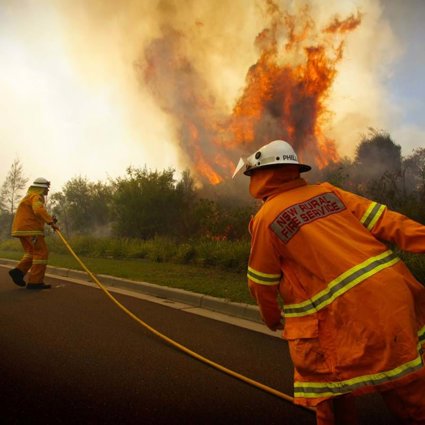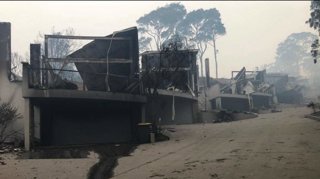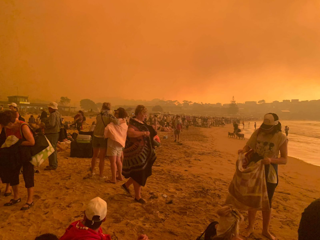
What has been the impact?
Tornadoes
Fires have burnt 12.4 million acres of Australia and are increasing in their scale and intensity. These natural hazards are now so fierce that the fires produce their own weather patterns. For example, a number of firefighters have been killed by unexpected tornadoes flipping fire engines. You will find informative diagrams about this natural occurrence from the Australian Government’s Bureau of Meteorology.
Loss of biodiversity
Since the breakup of the super continent Pangaea 250 million years ago Australia has continue to ‘drift’ southwards, breaking away from Antarctica in the process. It is now isolated from the rest of the world. This is significant because the animals and plants no longer had contact with creatures from other parts of the world and they therefore evolved independently. As a result, Australia has very high levels of endemism due to it being an island continent which is remote with long geographic isolation, tectonic stability and the unique and unusual pattern of climate change. Climate change has brought drier and more arid conditions to Australia which monotremes and marsupials have thrived in as their reproductive systems are less demanding. This is why Australian animals are so special and different from any other place in the world. 90% of mammals, 70% of the birds, 88% of the reptiles and 94% of the frogs in Australia are found nowhere else on earth. These fire are therefore both a natural hazard and an ecological disaster with an estimated 1 billion animals killed in the wildfires with many species now facing total extinction. Read about the 12 Australian animals most at risk.
Air pollution
Australia prides itself on its sporting achievements. Unfortunately, there have been major problems with air pollution in Victoria and New South Wales. The ATP tennis tournament of 2020 has experienced scheduling problems and has suffered international criticism over player welfare. On Monday 13 January Dalila Jakupović fell to her knees in a coughing fit when playing against against Switzerland’s Stefanie Vögele. Jakupović said afterwards:
‘I was really scared that I would collapse. That’s why I went onto the floor because I couldn’t walk any more’
Jakupović’s collapse has now become a globally circulated image showing the extent of Australia’s air pollution problems. The deterioration in air stems from the combustion of trees, leaves and ground vegetation as the wildfires burn. In these extreme wildfires solid carbon, gases (both CO² and CO) and water vapour are all released. The air quality situation has at times become very serious. Smoke inhalation is in fact the number one cause of death in wildfires due to asphyxiation (a lack of oxygen). Over 90% of emissions from wildfires are small enough to enter the respiratory system, which is a major health concern. When outside the ultrafine particles are impossible not to inhale as they measure less than 2.5 micrometres in size. Breathing in smoke can irritate the eyes, nose and throat however the more serious effects occur when these particles enter the lungs and blood stream. This risks infection of the heart, lungs and blood potentially causing septicaemia, urinary tract infections and renal failure. Pre-existing medical conditions such as chronic bronchitis, asthma and emphysema can also worsen. You can read more about the impact of smoke.
Water pollution
Water pollution is another major health concern as it has short and long term consequences. In the short term, Australians are in danger of untreated water causing gastrointestinal diseases leading to vomiting and diarrhea. In the long term, there is concern about the erosive effects of heavy rain on the fire-ravaged burnt earth. In addition, toxic blue-green algae has increased from nutrient rich runoff. The subsequent algae blooms, often polluting freshwater ponds, lakes, streams and brackish water ecosystems. It thrives in very hot areas, where there has been very little rain with poor circulation and lower water levels. You can read more about how, in some cases, boiling water is not even enough.
Mining
Coal production is partly to blame for the current wildfires, as it is the most polluting fossil fuel. Australia is the world’s biggest exporter of coal. In an ironic twist of fate coal has both contributed to and suffered from the wildfires as mining giant BHP announced that smoke was slowing production and the wildfires were ‘taking their toll’. It is important to realise that the economy of Australia heavily relies on mining, described in this article as one of the country’s five economic pillars. Mining now accounts for 10% of Australian GDP in 2020. Internationally, Australia is the third largest exporter of CO² (measured as fossil fuel consumption overseas)- read more. International concern is now focused on the huge increase in the release of carbon from the current wildfires. Reports estimate in this article that the Australian wildfires have released over 250 million tonnes of CO². Dr Pep Canadell, of the CSIRO climate science centre said there is concern that emissions will not be recaptured ‘by re-growing vegetation in a later stage’.

Personal account: Melinda Varcoe
The following is a direct quote from an Australian national called Melinda Varcoe who was staying in Malua Bay, just south of Batemans Bay, in New South Wales over the Christmas period.
‘Approximately 200m down our street there is bush land fire burning on the other side of the highway. 43 houses in Malua bay were burnt down with many spot fires in people’s front/ back yards. Random houses along the suburban streets burnt. Particularly those in which the residents didn’t stay to defend.’
‘Experiencing a wildfire is very surreal. We knew there were fires in different parts of the coast, but we just assumed we were safe. I think the fire that reached Malua bay travelled around 75km overnight which is why we were probably not as prepared as we should have been. I didn’t feel in immediate danger when at our house or when evacuated to the beach but I was worried for others.’
‘The community responded to the fires very well. It was amazing without phones and TV etc., everyone was outside asking their neighbours if they were okay, did they need help, food etc. many people joined there supplies and cooked a BBQ on their front lawn to use their food wisely as we did not know when power would be restored or when supermarkets would be open.’
You can locate Batemans Bay by clicking here
Personal account: Jessica Pickerings
The comments below are from another eye witness, Jessica Pickerings who was on holiday in Malua Bay, New South Wales.
‘Some effects that we struggled with were the smoke inhalation particularly on the New Year’s Eve when we evacuated to the beach for a few hours.’
‘Not having power and phone service - we couldn’t call or text family and friends who were worried about us to let them know we were ok. We couldn’t cook, have a hot shower, keep food in our fridge/ freezer for long but also couldn’t access shops because they were also closed.’
